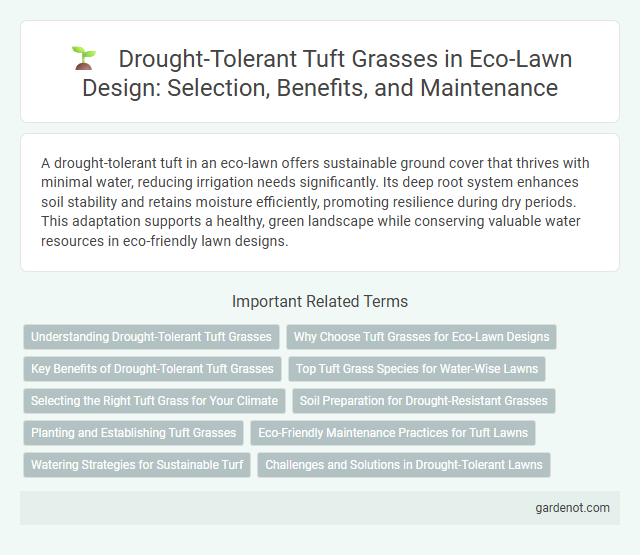A drought-tolerant tuft in an eco-lawn offers sustainable ground cover that thrives with minimal water, reducing irrigation needs significantly. Its deep root system enhances soil stability and retains moisture efficiently, promoting resilience during dry periods. This adaptation supports a healthy, green landscape while conserving valuable water resources in eco-friendly lawn designs.
Understanding Drought-Tolerant Tuft Grasses
Drought-tolerant tuft grasses, such as buffalograss and blue grama, possess deep root systems that efficiently access scarce water resources, making them ideal for eco-lawns in arid regions. These grasses exhibit adaptive physiological traits, including reduced leaf area and waxy surfaces, which minimize water loss through transpiration. Their resilience not only conserves water but also maintains green coverage under prolonged dry conditions, contributing to sustainable landscaping practices.
Why Choose Tuft Grasses for Eco-Lawn Designs
Tuft grasses are ideal for eco-lawn designs due to their exceptional drought tolerance, reducing water consumption significantly compared to traditional lawns. Their deep root systems enhance soil health by improving aeration and nutrient retention, promoting sustainable landscaping. Choosing tuft grasses supports resilient, low-maintenance eco-lawns that thrive in arid conditions while conserving natural resources.
Key Benefits of Drought-Tolerant Tuft Grasses
Drought-tolerant tuft grasses conserve water by requiring significantly less irrigation compared to traditional turf, making them ideal for eco-friendly lawns. Their deep root systems enhance soil stability and improve resilience against dry conditions, reducing the need for frequent watering and maintenance. These grasses also promote biodiversity by supporting native pollinators and reducing chemical fertilizer use.
Top Tuft Grass Species for Water-Wise Lawns
Drought-tolerant tufts such as buffalo grass, blue grama, and Bermuda grass are top grass species ideal for water-wise lawns due to their deep root systems and minimal irrigation needs. These grasses thrive in hot, dry conditions while maintaining a dense, green turf that resists soil erosion and requires less mowing. Selecting these species promotes sustainable lawn care by conserving water and reducing maintenance costs.
Selecting the Right Tuft Grass for Your Climate
Selecting drought-tolerant tuft grass tailored to your climate enhances eco-lawn sustainability by minimizing water usage and maintenance. Species like Buffalo grass thrive in arid regions due to their deep root systems and heat resistance, ensuring resilience during dry spells. Matching tuft grass varieties to local precipitation patterns and soil conditions optimizes growth and conserves natural resources effectively.
Soil Preparation for Drought-Resistant Grasses
Proper soil preparation for drought-tolerant tufts involves deep tilling to enhance aeration and water infiltration, paired with the incorporation of organic matter such as compost to improve moisture retention. Soil pH should be tested and adjusted to a slightly acidic to neutral range (6.0-7.0) to optimize nutrient availability for drought-resistant grasses. Establishing these conditions promotes robust root systems capable of sustaining growth during prolonged dry periods.
Planting and Establishing Tuft Grasses
Planting drought-tolerant tuft grasses requires well-prepared soil with good drainage and moderate moisture retention to support root development. Establish seedlings during early spring or fall when temperatures are mild, ensuring deep watering to encourage strong root systems while minimizing surface water loss. Regular monitoring for signs of stress and strategic irrigation during prolonged dry periods enhance establishment success and promote resilient, eco-friendly lawn coverage.
Eco-Friendly Maintenance Practices for Tuft Lawns
Drought-tolerant tufts in eco-lawns reduce water consumption by thriving with minimal irrigation, supporting sustainable landscaping. Implementing mulching and organic fertilizers enhances soil moisture retention and nutrient availability for tuft lawns. These eco-friendly maintenance practices promote healthy growth while conserving natural resources and minimizing environmental impact.
Watering Strategies for Sustainable Turf
Drought-tolerant tuft varieties in eco-lawns require minimal irrigation, promoting water conservation and sustainability. Implementing deep, infrequent watering strategies encourages robust root systems and reduces surface evaporation. Utilizing smart irrigation controllers and moisture sensors further optimizes water use, ensuring turf health during dry periods.
Challenges and Solutions in Drought-Tolerant Lawns
Drought-tolerant tufts in eco-lawns face challenges such as limited water availability, soil degradation, and increased heat stress, which hinder their growth and resilience. Solutions include selecting native, deep-rooted grass species, implementing efficient irrigation techniques like drip systems, and improving soil health with organic mulches to retain moisture. Integrating smart landscaping practices helps maintain lawn vitality while reducing water consumption in drought-prone areas.
Drought-tolerant tuft Infographic

 gardenot.com
gardenot.com